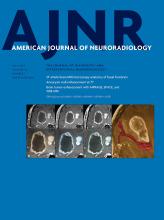Index by author
Jensen, T.R.
- Adult BrainOpen AccessQuantitative Delta T1 (dT1) as a Replacement for Adjudicated Central Reader Analysis of Contrast-Enhancing Tumor Burden: A Subanalysis of the American College of Radiology Imaging Network 6677/Radiation Therapy Oncology Group 0625 Multicenter Brain Tumor TrialK.M. Schmainda, M.A. Prah, Z. Zhang, B.S. Snyder, S.D. Rand, T.R. Jensen, D.P. Barboriak and J.L. BoxermanAmerican Journal of Neuroradiology July 2019, 40 (7) 1132-1139; DOI: https://doi.org/10.3174/ajnr.A6110
Jhaveri, A.
- EDITOR'S CHOICEPediatricsYou have accessPredictive Value of MRI in Diagnosing Brain AVM Recurrence after Angiographically Documented Exclusion in ChildrenA. Jhaveri, A. Amirabadi, P. Dirks, A.V. Kulkarni, M.M. Shroff, N. Shkumat, T. Krings, V.M. Pereira, V. Rea and P. MuthusamiAmerican Journal of Neuroradiology July 2019, 40 (7) 1227-1235; DOI: https://doi.org/10.3174/ajnr.A6093
The authors sought to determine the predictive values of contrast-enhanced MR imaging and TOF-MRA for brain AVM recurrence in children, compared with conventional angiography, in 39 patients (mean 10.8 years of age, mean Spetzler-Martin grade, 1.9). Features predictive of recurrence included a tuft of vessels on TOF-MRA and nodular juxtamural/linear enhancement with a draining vein on contrast-enhanced MR imaging. MR imaging is useful for surveillance after brain AVM treatment in children, but conventional angiography is required for definitive diagnosis of recurrence. TOF-MRA and contrast-enhanced MR imaging provide complementary information for determining brain AVM recurrence and should be interpreted in conjunction.
Junker, A.
- Adult BrainYou have accessWall Contrast Enhancement of Thrombosed Intracranial Aneurysms at 7T MRIT. Sato, T. Matsushige, B. Chen, O. Gembruch, P. Dammann, R. Jabbarli, M. Forsting, A. Junker, S. Maderwald, H.H. Quick, M.E. Ladd, U. Sure and K.H. WredeAmerican Journal of Neuroradiology July 2019, 40 (7) 1106-1111; DOI: https://doi.org/10.3174/ajnr.A6084
Kadono, Y.
- FELLOWS' JOURNAL CLUBNeurointerventionYou have accessLong-Term Results and Follow-Up Examinations after Endovascular Embolization for Unruptured Cerebral AneurysmsT. Murakami, T. Nishida, K. Asai, Y. Kadono, H. Nakamura, T. Fujinaka and H. KishimaAmerican Journal of Neuroradiology July 2019, 40 (7) 1191-1196; DOI: https://doi.org/10.3174/ajnr.A6101
The appropriate period of follow-up examinations after endovascular embolization for cerebral aneurysms using time-of-flight MR angiography is not well-known. Between April 2006 and March 2011, one hundred forty-eight unruptured aneurysms were treated with endovascular coil embolization. Among them, the authors investigated 116 unruptured aneurysms, which were followed up for >5 years. Time-of-flight MRA was performed at 1 day, 3–6 months, 1 year after the procedure, and every year thereafter. The mean follow-up period was 7.0 years. Recanalization was observed in 19 (16.3%) aneurysms within 2 years. Among them, retreatment was performed in 8 (6.8%) aneurysms. No recanalization was detected in any aneurysms that had been stable in the first 2 years after embolization. They conclude that aneurysms in which recanalization was not observed within 2 years after endovascular coil embolization were stable during a mean follow-up of 7 years. This result may be helpful in considering the appropriate span or frequency of follow-up imaging for embolized cerebral aneurysms.
Kaelin-lang, A.
- EDITOR'S CHOICEAdult BrainYou have accessBrain Tumor-Enhancement Visualization and Morphometric Assessment: A Comparison of MPRAGE, SPACE, and VIBE MRI TechniquesL. Danieli, G.C. Riccitelli, D. Distefano, E. Prodi, E. Ventura, A. Cianfoni, A. Kaelin-Lang, M. Reinert and E. PravatàAmerican Journal of Neuroradiology July 2019, 40 (7) 1140-1148; DOI: https://doi.org/10.3174/ajnr.A6096
Fifty-four contrast-enhancing tumors (38 gliomas and 16 metastases) were assessed using MPRAGE, VIBE, and SPACE techniques randomly acquired after gadolinium-based contrast agent administration on a 3T scanner. Enhancement conspicuity was assessed quantitatively by calculating the contrast rate and contrast-to-noise ratio, and qualitatively, by consensus visual comparative ratings. Compared with MPRAGE, both SPACE and VIBE obtained higher contrast rate, contrast-to-noise ratio, and visual conspicuity ratings in both gliomas and metastases. The authors conclude that superior conspicuity for brain tumor enhancement can be achieved using SPACE and VIBE techniques, compared with MPRAGE.
Kames, C.
- PediatricsYou have accessQuantitative Analysis of Punctate White Matter Lesions in Neonates Using Quantitative Susceptibility Mapping and R2* RelaxationY. Zhang, A. Rauscher, C. Kames and A.M. WeberAmerican Journal of Neuroradiology July 2019, 40 (7) 1221-1226; DOI: https://doi.org/10.3174/ajnr.A6114
Kavanagh, Eoin C.
- You have accessPerspectivesEoin C. KavanaghAmerican Journal of Neuroradiology July 2019, 40 (7) 1083; DOI: https://doi.org/10.3174/ajnr.P0078
Kennedy, T.A.
- LetterYou have accessReply:T.A. KennedyAmerican Journal of Neuroradiology July 2019, 40 (7) E37; DOI: https://doi.org/10.3174/ajnr.A6094
Key, S.R.
- You have accessAssessment of Explicitly Stated Interval Change on Noncontrast Head CT Radiology ReportsM. Braileanu, K. Crawford, S.R. Key and M.E. MullinsAmerican Journal of Neuroradiology July 2019, 40 (7) 1091-1094; DOI: https://doi.org/10.3174/ajnr.A6081
Kim, J.
- Extracranial VascularYou have accessComparison of Carotid Endarterectomy and Stenting for Symptomatic Internal Carotid Artery Near-OcclusionJ. Kim, S. Male, D. Damania, B.S. Jahromi and R.P. TummalaAmerican Journal of Neuroradiology July 2019, 40 (7) 1207-1212; DOI: https://doi.org/10.3174/ajnr.A6085








